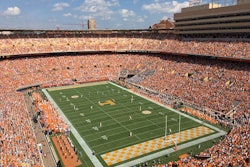Copyright 2017 Orange County Register
All Rights Reserved
Orange County Register (California)
Gus Martinez, Fullerton Union High's football coach, said he did a backflip when he heard the Fullerton Joint Union High School District recently approved the installation of artificial turf fields at its three football stadiums.
He was joking, of course. But delighted nonetheless.
"So excited," he said. "This'll make us more competitive in all sports."
Forthcoming designs for stadium renovations at Buena Park, Fullerton Union and La Habra high schools will include artificial turf fields, said Todd Butcher, the district's facilities and construction director. New fields will feature a virgin rubber infill rather than recycled crumb rubber, the product used for most high school, college and professional fields.
The change was supported by district sports teams, bands and outside users of the fields, Butcher said. Later this month, Fullerton Union's stadium designs should be submitted for approval.
"This is a huge step for all our students in that the field can be used 365 days a year, all day long," Butcher said. "I've had many, many years of installing these artificial fields, and they've done nothing but improve every after-school activity: band, ROTC, athletics."
Revenue from Measure I, the district's $175 million bond measure approved by voters in 2014, will fund the renovations.
Installing an artificial turf field costs $960,000, a staff report says. Annual maintenance amounts to $13,000 - manicuring a grass field costs $56,000 per year.
Installation would take up to four months, Butcher said. Depending on use and maintenance, fields will require replacing every eight to 12 years. By installing artificial turf, the district expects to save more than $300,000 over five years on maintenance and replacement costs.
"It's worth the initial investment," Butcher said, "and not for the benefit of saving dollars, but for the reallocation of manpower that will improve the existing facilities throughout the district without increasing staff."
Most events held on the grass fields can continue, Butcher said. Also, local feeder sports programs would be able to practice at the high schools.
Those youth teams "would be practicing in safer facilities," Butcher said, "which hopefully would inspire them to come to our high schools."
Perhaps most importantly, artificial turf fields needn't close for maintenance throughout the year.
Martinez sees the benefit of keeping the school's football field open in the summer and at night.
"We're very limited on space on campus," Martinez said. "We have very few places to practice, and on rainy days, we're at the college; we're not even at our own field or else it'd be torn up and shot for the rest of the year.
"For our athletes to be able to practice year-round, without having to deal with all the things that come along with a grass field, is huge."
Read More of Today's AB Headlines
Subscribe to Our Daily E-Newsletter
Terms and Conditions Privacy Policy



































